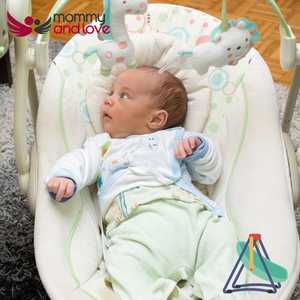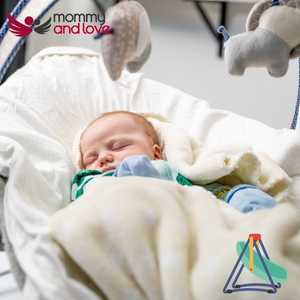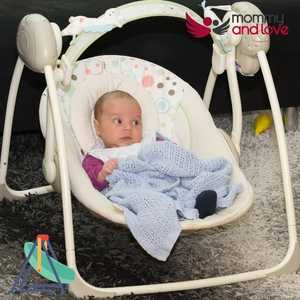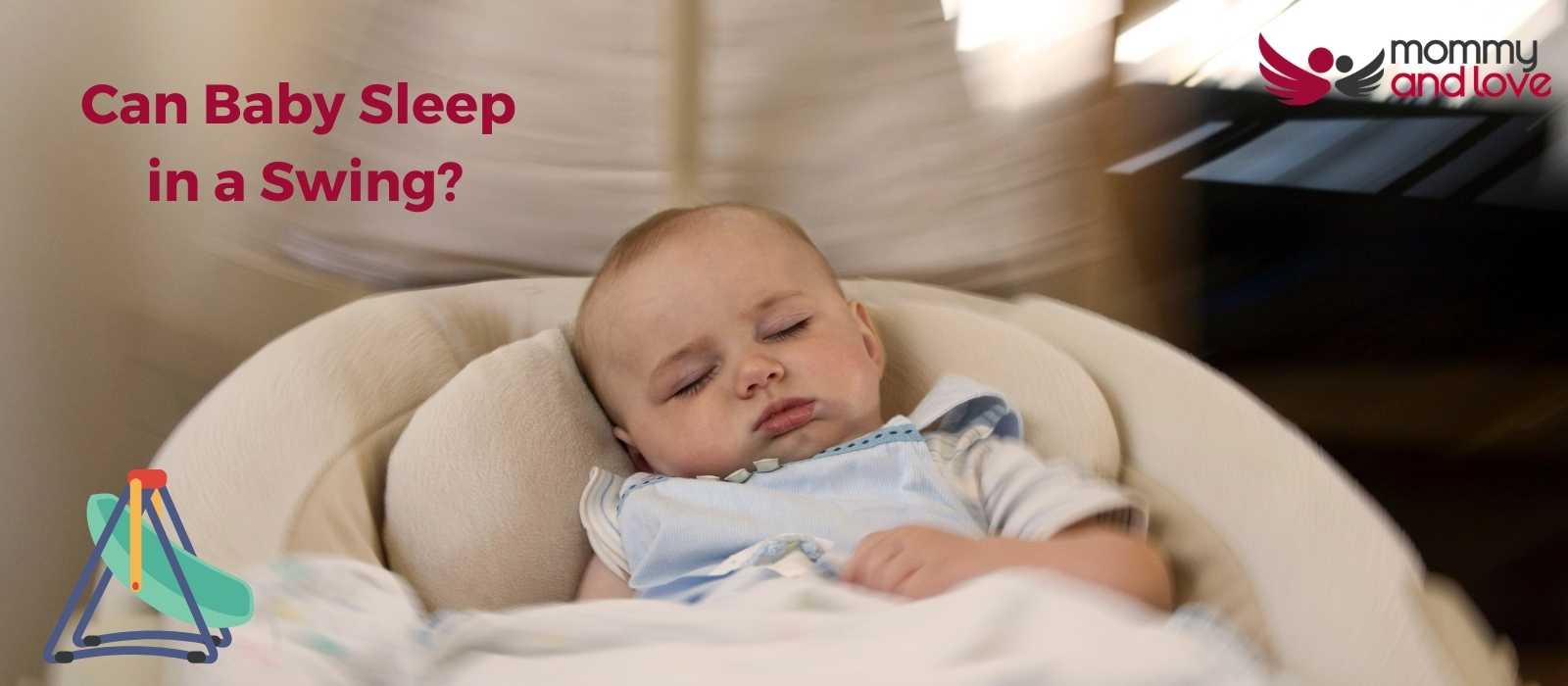Most parents wonder if it’s safe for their baby to sleep in a swing. The answer is no.
The American Academy of Pediatrics suggests that parents move their babies from the swing to a safe sleeping place when they fall asleep in the swing. A baby’s swing is not a replacement for a crib or bassinet.
Affiliate Disclaimer: As an Amazon Associate, we earn from qualifying purchases.
Is It Safe for Babies to Sleep in a Swing?
The American Academy of Pediatrics (AAP) recommends moving your baby from the swing to a safe sleeping place if they fall asleep in the swing, it is not safe for a baby to sleep in a swing. A recent study by AAP show that 3% of baby deaths while sleeping occurred in a swing, these are designed for sitting in not sleeping in.
There are several reasons why it’s not recommended to let a baby nap on a sitting device like a swing.
First, swings aren’t as firm as a crib or bassinet, so there’s a greater risk of a baby rolling off and being injured. Second, the AAP and most safe sleep experts recommend babies sleep on their backs on firm and flat surface like the one on a crib to reduce the risk of Sudden Infant Death Syndrome (SIDS). A firm surface is the most ideal place for babies to sleep.
When babies are asleep in swings, they’re often in a semi-upright position rather than reclined position, which isn’t ideal for sleep because they don’t have muscle strength. It can also strain your baby’s neck muscles which are not fully developed.
If you’re wondering what to do if your baby falls asleep in the swing, the best thing to do is transfer them to a safe flat surface where your baby can safely sleep. This will help reduce the risk of injury, ensure that your baby is getting the best possible sleep, and keep your sleeping baby safe.
What Are the Benefits of Baby Swings?

Generally, swings are safe to use when a baby is awake. And there are many benefits of infant swings, including providing a soothing motion that can help your fussy baby sleep, as well as giving you a much-needed break.
Swings can also help to stimulate your baby’s development and provide them with visual and auditory stimulation.
In addition, infant swings can be a great way to keep your baby occupied and entertained while you get some things done around the house.
If you’re considering purchasing a baby swing, it’s important to do your research and choose one that is right for your baby’s needs. Moreover, you should also know the associated risks of using one especially not letting your child sleep in the swing.
There are many different types of infant swings on the market, so be sure to read reviews from other parents and compare features before making your final decision. You can also do these things when buying any infant products.
With so many great options available, you’re sure to find the perfect baby swing for your little one. We love these swings:
What Are the Cons of Baby Swings?
The answer may surprise you – there are very few, other than not letting babies sleep in them!
Baby swings can provide a much-needed sense of security and comfort for your little one and can be an invaluable tool in helping them to be calm. However, there are a couple of potential downsides that you should be aware of.
One potential downside of swings is that they can become a crutch, and your baby may become reliant on them in order to fall asleep, especially when used at night. If your baby is used to falling asleep in the swing, you may find it difficult to wean them off the swing once they reach a certain age. Sleep training may help you and your baby not be dependent on the rocking motion of a swing.
Another potential downside is that swings can be quite noisy, and if you have an older child who is trying to have a nighttime sleep, the constant movement and noise can be disruptive.
Overall, swings are a fantastic tool that can provide immense comfort and security for your little one. However, it is important to be aware of the potential downsides so that you can make an informed decision about whether or not a swing is right for your family.
What Are the Risks of Using Baby Swings?
There are a few risks associated with using swings, including the potential for entrapment or strangling. Swings can also tip over if not used correctly, which could result in serious injury and infant deaths. Additionally, a baby might slump forward until she can’t breathe.
It’s important to carefully read the instructions before using a baby swing and to never leave your baby unattended especially if there’s a baby sleeping in the swing at night.
What to Look For in a Baby Swing

When it comes to finding the perfect baby swing for your little one, there are a few things you’ll want to keep in mind. First, consider the size and weight of your child. You’ll want to make sure the swing can accommodate them comfortably.
Additionally, think about how easy the swing is to set up and takedown. You don’t want something that’s going to be a hassle every time you use it.
Take into account the features offered by different swings. Some have music and lights, while others offer more simple designs. Consider what would work best for your family and your lifestyle.
Finally, make sure the swing meets the standards set by the Consumer Product Safety Commission.
With these factors in mind, you’ll be sure to find the perfect baby swing for your baby’s needs.
When Can Babies Use Swings?

Swinging is a great way to get your baby moving, but it’s important to know when they can start using a swing.
Babies can usually start using a swing at birth until the first few months or when they reach a certain weight. The AAP recommends swings with the most reclined position for babies under 4 months old.
Once your baby reaches the age of 6 months, you teach your baby sleep training so she can stop falling asleep in her swing. It’s important for babies to learn how to sleep on their own at a young age. You should gradually train them not to sleep while in their swings or bouncy chairs and to only sleep while they are on their crib or bed.
When Do Babies Stop Using Infant Swings?
Most babies will outgrow swings by the time they are around six months old. However, some may be able to use them for a little longer if they are not too heavy or tall for the swing. You can usually tell when your baby has outgrown their swing as they will start to look uncomfortable in it or try to climb out of it.
Infant swings always come with up-to-date information regarding height and weight limits and safety guidelines from the manufacturer such as those made by Fisher Price.
Conclusion
Swings can be a great way to soothe your baby and help them fall asleep, but they are not a replacement for a crib or bassinet. The American Academy of Pediatrics expert advice is that when a baby falls asleep in the swing while in a seated position, parents should move the sleeping baby to a firm sleep surface like a crib or bassinet.
FAQ
Is It Safe for My Baby to Sleep in a Car Seat?
The short answer is no. It can be dangerous for infants to sleep in car seats. Here’s why:
When babies sleep in car seats, the baby’s head can flop forward. This can block their airway and make it difficult for them to breathe. Additionally, infants who sleep in car seats are at an increased risk of suffocation.
So what’s the best way to keep your sleeping child safe and comfortable while you’re on the road? The AAP policy explained that infants under the age of 12 months should not sleep in a car seat for prolonged periods or more than two hours at a time.
If you’re going to be on the road for more than two hours, you should take safety precautions especially when your baby tends to sleep while on the road.
Parents should plan to stop every few hours to let their baby stretch their legs and move around. And of course, always make sure your babies stay asleep and are properly secured in their car seat and baby gear when you’re driving.






